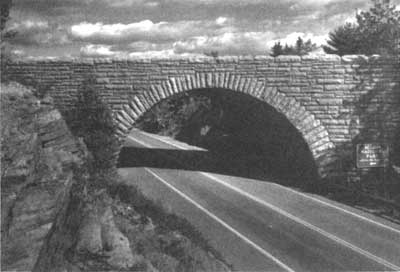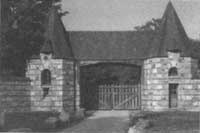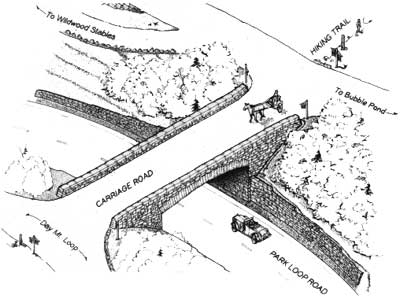 | ||
 | ||
 | ||
 | ||
 | ||
 | ||
 | ||
 | ||
 | ||
 | ||
 | ||
 | ||
 | ||
 | ||
 | ||
 | ||
 | ||
 |
 |
 |
Acadia Roads and Bridges
Acadia National Park, Maine

Constructed by the Federal Government in 1952, the Route 233 Overpass Bridge on Paradise Hill Road, provides for a dramatic and safe grade separation at the intersection of the state highway. Built after World War II, the span reflects the aesthetics of earlier masonry designs. (JTL) |
FEDERAL ROAD-BUILDING

Brown Mountain Gate House reinforces the separation of autos from carriages. (JTL) |
Although the greatest road-building effort in Acadia was initiated by Rockefeller, several segments were developed by the National Park Service in cooperation with the Bureau of Public Roads (BPR), now known as the Federal Highway Administration. This agency has been responsible for all transportation design in the national parks since 1926. The Cadillac Mountain Road (1932), Paradise Hill Road (1952) and segments of the Otter Creek Cove section were designed and engineered by the BPR with input from the Rockefeller team and others. During the Great Depression of the 1930s Civilian Conservation Corps camps were posted and duties included roadside landscaping and sign construction, all of which added to the final character of the road systems. Simultaneous projects created a flurry of activity in the park as carriage and motor roads began to weave over and under each other at intersections as topography allowed.
KEEPING THE SYSTEMS SEPARATE
In many ways the carriage and motor roads of Acadia National Park appear quite distinct. Signs, grade separations and two picturesque gatehouses remind today's visitors that these two systems were intended to be kept physically separate. However, the traveler also experiences a certain consistency through shared design details, such as variations on the border stones, known affectionately as "Rockefeller's Teeth," along the road shoulder. The similarities between Acadia's carriage and motor roads also lies at the heart of their shared history. Both were built in response to the rise of the automobile and each was influenced by the aesthetic vision of John D. Rockefeller, Jr. It is this common heritage that visitors atop Cadillac Mountain can recall while they watch the sunrise over the Atlantic horizon from the front seats of their automobiles.

Drawing by Ed Lupyak, HAER 1995 |
| Introduction | Acadia | Blue Ridge Parkway | Chickamauga and Chattanooga | Colonial Parkway | Generals Highway | George Washington Memorial Parkway | Great Smoky Mountains | Mount Rainier | Rock Creek and Potomac Parkway | Shenandoah's Skyline Drive | Southwest Circle Tour | Vicksburg | Yellowstone | Yosemite |
